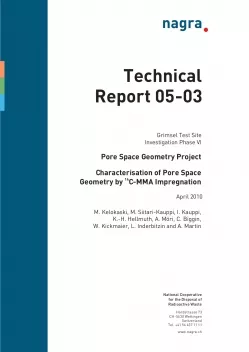
Technical Report NTB 05-03
Grimsel Test SiteInvestigation Phase VIPore Space Geometry ProjectCharacterisation of Pore Space Geometry by 14C-MMA Impregnation
In Finland high-level radioactive waste is planned to be disposed of in a deep geological repository within a crystalline host rock. The potential role of the geosphere as a safety barrier in repository performance assessment is well established. However uncertainties in both transport pathway definition and pore space characterisation of crystalline rock still exist and the repository safety evaluation today requires going from laboratory and surface-based field work to the underground repository level. Little is known about the changes to rock transport properties during sampling and decompression. Recent investigations using resin impregnation of the rock matrix at the Grimsel Test Site imply that non-conservative errors in calculated transport properties derived from laboratory data may reach factors of two to three.
Due to the potentially great significance of pore space characterisation to safety analysis calculations, it was decided to study the rock matrix characteristics in situ using methylmethacrylate (MMA) resin labelled with 14C. During the last decade, the poly-methylmethacrylate (PMMA) method has been developed for characterising the porosity of low permeable granitic rocks in the laboratory. Impregnation with 14C-labelled methylmethacrylate (14C-MMA) and autoradiography allows investigation of the spatial distribution of accessible porosity at the centimetre scale. Quantitative measurements of total or mineral-specific local porosities have been obtained using image analysis tools. Electron microscopy examinations and mercury porosimetry measurements have provided detailed information on pore and fissure apertures.
The objective of this work was to develop an in situ application of the PMMA impregnation technique. The changes in rock porosity due to stress relaxation when overcoring the samples from the bedrock for the laboratory studies were examined. The concept behind the work was to inject 14C-MMA from a central borehole at a depth of around 1 metre from the tunnel wall within a 20 cm injection interval. It was assumed that six additional smaller diameter radial boreholes would permit increased drying of the rock matrix and that intrusion of MMA would be observed from the observation boreholes during the injection of the resin. The two main differences between in situ and laboratory PMMA impregnations were: 1) drying in situ was done by ventilating warm air whereas in the laboratory, samples were dried by heating in a vacuum; 2) polymerisation in situ was through auto polymerisation whereas in the laboratory polymerisation was achieved by irradiation of the samples.
It was found that air ventilation drying around the injection borehole was not effective enough to dry the rock matrix when 14C-MMA impregnation was applied in situ. However the penetration of 14C-MMA into Grimsel granodiorite in situ was successful. Autopolymerisation of the resin reduced the amount of impregnation, but the thermal polymerisation succeeded well. The MMA intruded to depths of 2-5 cm from the injection borehole; with maximum penetration along the foliation of the rock texture. The amount of PMMA showed clearly a decreasing trend from injection borehole surface to a depth of 5 cm in the rock matrix.
